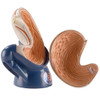Description
Hand-painted in contrasting colors to accentuate subtle features, this anatomically-correct resilient vinyl replica splits into halves to access its hollow interior, convoluted rugae and pyloric valve. External details include the gastric artery, gastric nerve plexus, and dissections of the anterior stomach wall, at progressive depths, exposing its three muscular layers.
Value Feature: The detachable molded display base incorporates the proximal portion of the duodenum, sectioned open, demonstrating its relationship to the stomach.
The accompanying key identifies 17 features which have been hand numbered on the model.
- Esophagus. Food is carried from the mouth to the stomach by the Esophagus.
- Cardia. The Cardia (or “cardiac orifice”) is where the esophagus opens into the stomach. (Shown outside the stomach.)
- Fundus. The Fundus of the stomach is
the dome-shaped portion above the Cardia (#516). Inside the body, it is located directly below the left dome of the diaphragm. - Pylorus. The section of the stomach near the Pyloric Sphincter (409).
- Lesser Curvature. The upper, concave curve (margin) of the stomach.
- Greater Curvature. The outer, convex curve of the stomach. This curve is 4 or 5 times longer that the Lesser Curve (398).
- The groove identified by #400 is the attachment point of the Hepatogastric Ligament; which, when combined with the Hepatoduodenal Ligament, forms the Lesser Omentum. This groove can be seen running inside the entire Lesser Curva- ture of the stomach. A similar groove, found along the Greater Curvature of the stomach is the attachment point for the Greater Omentum.
The three muscular layers of the stomach wall are numbered #401 to # 403 and #408. A section on the anterior side of the model shows the outer wall of the stomach removed to allow examination of each of the three layers.
401. Outer Longitudinal Muscles. The outermost layer. These muscles are more concentrated along the lesser and greater curvatures.
402. Intermediate Circular Muscles. These muscles are fairly evenly distributed around the stomach.
403. (& 408) Inner Oblique Muscles. The intestine has only two muscular layers, the Outer Longitudinals, and the Interme- diates. The stomach has this third layer, which tends to be concentrated along the body of the stomach, in contrast to the Outer Longitudinals, which are more concentrated along the curvatures.
404. Gastric Artery and its right branches 405. Gastroepiploic Artery
406. Gastric Nerve Plexus
External Structures
Internal Structures
- Rugae. The inner layer of the stomach (the mucosa) forms folds, called rugae. Most of these folds are longitudinal. Taken together, these longitudinal folds form a grooved channel called the Gastric Canal. Some of the folds, however, do not form longitudinally. Rather, they combine to form a honeycomb-like appearance as shown near the opening form the Esopha- gus. These folds tend to disappear when the stomach is full.
- Inner Oblique Muscles
- Pyloric Sphincter. The opening from the stomach to the Duodenum is called the “pylorus”. At the “pylorus”, there is a marked thickening of the Intermediate Circular Muscles (#522) which act as a valve to open and close this opening.













